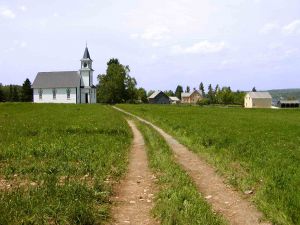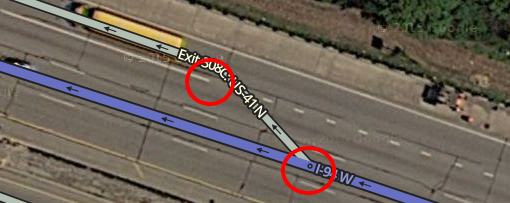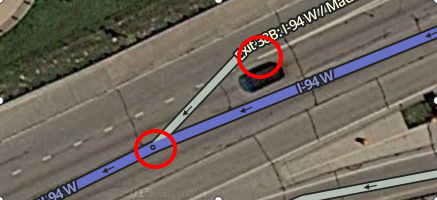(→Major_roads/Main: Fix Forest Service Roads wiki link) |
(Changed BOSE to True Elevation) |
||
| Line 61: | Line 61: | ||
=== | === True Elevation === | ||
Wisconsin | Wisconsin uses the concept of True Elevation on segments within the State. The use of '''True Elevation''' (TE) is to better represent segments in relationship with its surroundings/ground level. Most segments should have an elevation of ground unless they pass over another segment, waterway, or natural feature. '''Drivable and non-drivable segments are handled the same way with elevation'''. | ||
The | '''The practice of True Elevation is NOT observed on freeway or ramp segments.''' | ||
For freeway and ramp segments please reference national guidance [[Creating and editing road segments#Road elevation|Road Elevation]] and [[Overpasses, Underpasses and Bridges]]. | |||
'''Definitions''' | |||
''' | ''Bridge'' | ||
* Segment travels over another segment (also known as overpass) | |||
* Segment travels over a river or body of water | |||
* | * Segment artificially elevated to pass over ground level objects and natural features. | ||
* | |||
''' | ''Tunnel'' | ||
A tunnel is any road segment that is underground and thus the GPS reception is inconsistent. | |||
'''Implementation''' | |||
* Elevation of overlapping segments should be set relative to each other, with the lowest segment as Ground (unless that segment is a tunnel). | |||
* Only elevate/lower the actual bridge/tunnel section of the road. | |||
* Bridges should be cut at the start/end of the bridge where the land falls away. You can usually see guardrail at the start/end of the bridge section. | |||
** Do not cut segments for elevation purposes if the bridge starts/stops within 500ft/150m of an existing junction. | |||
**Do not create a segment less than 200ft/60m in length | |||
** No need to elevate segments over every small creek or box culvert. Only elevate over significant waterways or natural features. | |||
* Only set elevation as low/high as necessary. For example, no segment should be Elevation +2 unless it passes over another segment with Elevation +1. | |||
'' | * Tunneled segments shall have lower elevation, relative to ground and ''Tunnel'' should be checked. | ||
* Only segments that are actually '''underground''' should have the negative elevation. | |||
* Tunnels should be cut at least 50ft/15m before and after the tunnel, to allow time for the GPS to regain signal. | |||
* '''The use of common sense is paramount in using True Elevation.''' | |||
''NOTE: If you use the Bridge tool to join segments, be aware that it raises the elevation of the joined segment. Lower the joined segment as appropriate.'' | |||
=== Additional Notes For Wisconsin === | === Additional Notes For Wisconsin === | ||
Revision as of 16:09, 6 October 2020
Functional Classification
Wisconsin follows the Functional Classification (FC) system for the USA.
To help update the current Wisconsin roadways to the new functional classifications, go to the Wisconsin Functional Classification Inventory.
Links to the FC maps for the state of Wisconsin can be found on the Wisconsin/Resources page.
Name Normalization
Wisconsin uses the following standards for road naming:
Freeways - I-###
US Highways - US-###
State Highways - WIS-###
County Highways - CH-XXX
Forest Roads - FR-###
| There are no Township (Town) Roads in the state. All Town Roads are named, and those names will be used. The only exceptions would be if the road signage states differently. |
Quick reference chart
Refer to this chart to determine the road type of a given paved public road based on the functional class.
| Highway Systems | |||||||||
|---|---|---|---|---|---|---|---|---|---|
| Interstate | US Hwy | US Hwy Business | State Hwy | State Hwy Business | County Highway | Locally-maintained | |||
| example | I-94 E | US-151 | US-151 BUS | WIS-23 | WIS-11 BUS | CH-B | Robertson St | ||
| F u n c t i o n a l C l a s s |
Interstate | Fw | n/a | n/a | n/a | n/a | n/a | n/a | |
| Other Freeway | n/a | Fw | Fw | Fw | Fw | Fw | Fw | ||
| Principal Arterial | n/a | Major | Major | Major | Major | Major | Major | ||
| Minor Arterial | n/a | Major | Minor | Minor | Minor | Minor | Minor | ||
| Major Collector | n/a | Major | Minor | Minor | PS | PS | PS | ||
| Minor Collector | n/a | Major | Minor | Minor | PS | PS | PS | ||
| Local/not mapped | n/a | Major | Minor | Minor | PS | PS | Street | ||
True Elevation
Wisconsin uses the concept of True Elevation on segments within the State. The use of True Elevation (TE) is to better represent segments in relationship with its surroundings/ground level. Most segments should have an elevation of ground unless they pass over another segment, waterway, or natural feature. Drivable and non-drivable segments are handled the same way with elevation.
The practice of True Elevation is NOT observed on freeway or ramp segments.
For freeway and ramp segments please reference national guidance Road Elevation and Overpasses, Underpasses and Bridges.
Definitions
Bridge
- Segment travels over another segment (also known as overpass)
- Segment travels over a river or body of water
- Segment artificially elevated to pass over ground level objects and natural features.
Tunnel
A tunnel is any road segment that is underground and thus the GPS reception is inconsistent.
Implementation
- Elevation of overlapping segments should be set relative to each other, with the lowest segment as Ground (unless that segment is a tunnel).
- Only elevate/lower the actual bridge/tunnel section of the road.
- Bridges should be cut at the start/end of the bridge where the land falls away. You can usually see guardrail at the start/end of the bridge section.
- Do not cut segments for elevation purposes if the bridge starts/stops within 500ft/150m of an existing junction.
- Do not create a segment less than 200ft/60m in length
- No need to elevate segments over every small creek or box culvert. Only elevate over significant waterways or natural features.
- Only set elevation as low/high as necessary. For example, no segment should be Elevation +2 unless it passes over another segment with Elevation +1.
- Tunneled segments shall have lower elevation, relative to ground and Tunnel should be checked.
- Only segments that are actually underground should have the negative elevation.
- Tunnels should be cut at least 50ft/15m before and after the tunnel, to allow time for the GPS to regain signal.
- The use of common sense is paramount in using True Elevation.
NOTE: If you use the Bridge tool to join segments, be aware that it raises the elevation of the joined segment. Lower the joined segment as appropriate.
Additional Notes For Wisconsin
New Roads
It is important to remember to add House Numbers (HNs) when adding new roads to Waze. Waze will not be doing any future imports or merges of external data for house numbers. This ensures that Waze will provide accurate routing to those new addresses. If you come across a new road that is part of a new residential development but HNs are not yet available, please add the road to the Wisconsin New Development Tracking Sheet. Add any relevant information to the project that you may have. This sheet is used to keep track of new developments to ensure roads and HNs get added to the map as quick as possible.
Dirt Roads

All drivable unpaved (Dirt/Gravel) roads should be classified as per Functional Classification. The Unpaved checkbox should then be selected. Use the unpaved road attribute when the road is dirt or gravel but is maintained or improved by the city or county. This means that road is graded and leveled from time to time.
Trails and non-standard roads that may require special equipment to drive on, should either not be mapped, or be classified as an Off Road / Not Maintained. The Off-Road/Not Maintained road type will be used for 2-track jeep trail type unimproved roads. The Off-Road/Not Maintained type of roads are normally found in the rural areas of the state and should rarely be used around or in any city environment.
Using unpaved on a Local Street road type adds a time penalty to those segments of road and using Off-Road adds a larger time penalty. The time penalty is used by the routing server to determine the fastest route. In the app, there is a setting for Dirt roads. This can be set to Allow, Don’t Allow, and Avoid long ones. Just small lengths of Off-Road/Not Maintained will add a significant time penalty and these roads will be avoided by the app and may give users very long routes where the unpaved road attribute would have saved hours of time.
If you can't decide on what type to use just think, if a typical highway vehicle could easily travel at 15-25 mph should be considered a Local Street with the Unpaved road attribute.
Toll Roads
There are currently no toll roads in Wisconsin. No segments within the State of Wisconsin should be marked as 'Toll Road'.
Pedestrian Boardwalk, Walking Trail, Stairway
These should not be mapped without approval from a State Manager for Wisconsin or the Regional Coordinator. These segment types can cause routing issues even when not connected to a drivable segment.
Solid White Lines
It is not illegal to cross a solid white line in the State of Wisconsin, unless posted Wisconsin Statute 346.13(3).

Some examples are: road edge lines, lane divider lines, or on/off ramp lane lines. Even though it is not illegal, it is a safe driving practice to not cross these lines. When mapping on/off ramps, please follow national guidelines in the Junction Style Guide/Interchange page.


There may be times when this is impractical, in such instances, contact a State Manager for further guidance.
Roundabouts at Freeway Interchanges
When there are roundabouts at freeway interchanges, leave the connecting overpass/underpass roads un-named. Waze will read forward to the next roundabout and provide proper TTS and visual prompts for the user to aid in proper lane selection at multi-lane roundabouts.
Here is an example of when not to name the segment(s): Do Not Name
U-Turns
U-turns in Wisconsin are permitted when:[1]
- The u-turn can be made in safety and without interfering with other traffic.
- Not upon any curve, or upon the approach to or near the crest of a grade, where the vehicle cannot be seen by the driver of any other vehicle approaching from either direction within five hundred (500) feet.
- Not explicitly prohibited by signage or local municipal law.
- You are not required to back up during the course of the u-turn in order to complete it.
For Waze routing, u-turns should only be enabled where they provide the potential for improved routing, which includes recovering from missed turns. A common example is a median-divided primary street that has homes/businesses with their driveways/entrances directly on it, where reaching them would otherwise require lengthy, multi-turn deviations through side roads in order to end up on the correct side of the median.
U-Turns are not allowed on any Freeway or Expressway.
Construction Zones
If a construction zone is expected to last one week or longer, the following options are allowed to be made to the area:
- Change speed limit to lower posted limit
- Add crossovers for traffic changes and make one-way Freeway segments two-way.
If any or all of these changes are made, add the construction zone to the following spreadsheet for easy reference and followup by other editors. WI Construction Zones
Locking standard
The following defines a set of minimum locking standards proposed for all roads within Wisconsin. Any road of a certain type or category must be locked at least to the level in the chart below. Roads may be locked higher for protection and special situations (tricky design, frequent mistakes, imaging inaccuracies, and the like), but should not be locked lower.
It is understood that more rural or inactive areas may not yet meet this standard: editors are encouraged to recruit and mentor additional editors to build coverage.
A great time to implement these locks is while bringing the road types of an area into compliance with the current US road type standards (FC and highway systems). Lock the roads based on type after they've been set to current US Road Type Standards.
| Segment Type | Two-way | One-way | |||||||||
|---|---|---|---|---|---|---|---|---|---|---|---|
| Freeway | 5 | ||||||||||
| Ramp | Highest lock of connected segment | ||||||||||
| Major Highway | 3 | ||||||||||
| Minor Highway | 3 | ||||||||||
| Primary Street | 2 | 3 | |||||||||
| Street | 1 | 2 | |||||||||
| Private Road | 1 | 2 | |||||||||
| Parking Lot Road | 1 | 1see note | |||||||||
| • • • • Ferry • • • • | 5 | ||||||||||
| |-|-|-|-|-|-|-|-|-| Railroad |-|-|-|-|-|-|-|-|-| | 2 | ||||||||||
| ⁃ ⁃ ⁃ ⁃ ⁃ Runway ⁃ ⁃ ⁃ ⁃ ⁃ | 5 | ||||||||||
| Other named types | 1 | 2 | |||||||||
| Construction (outdated imagery) | 3 | ||||||||||
| Waze Beacons installed | 6 | ||||||||||
Note: One-way PLRs used outside of parking lots, such as alleys and streets through apartment complexes, should be locked at 2. See the GLR major roads page for additional information on the standards listed here.